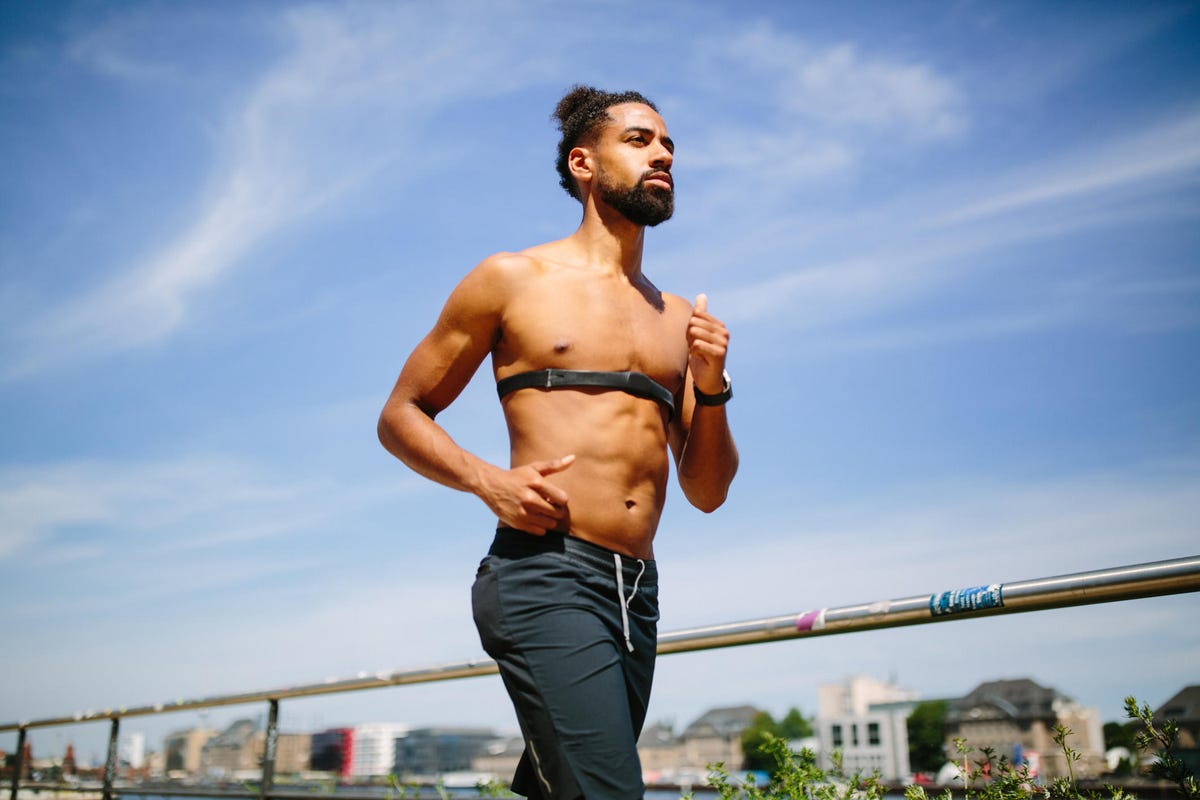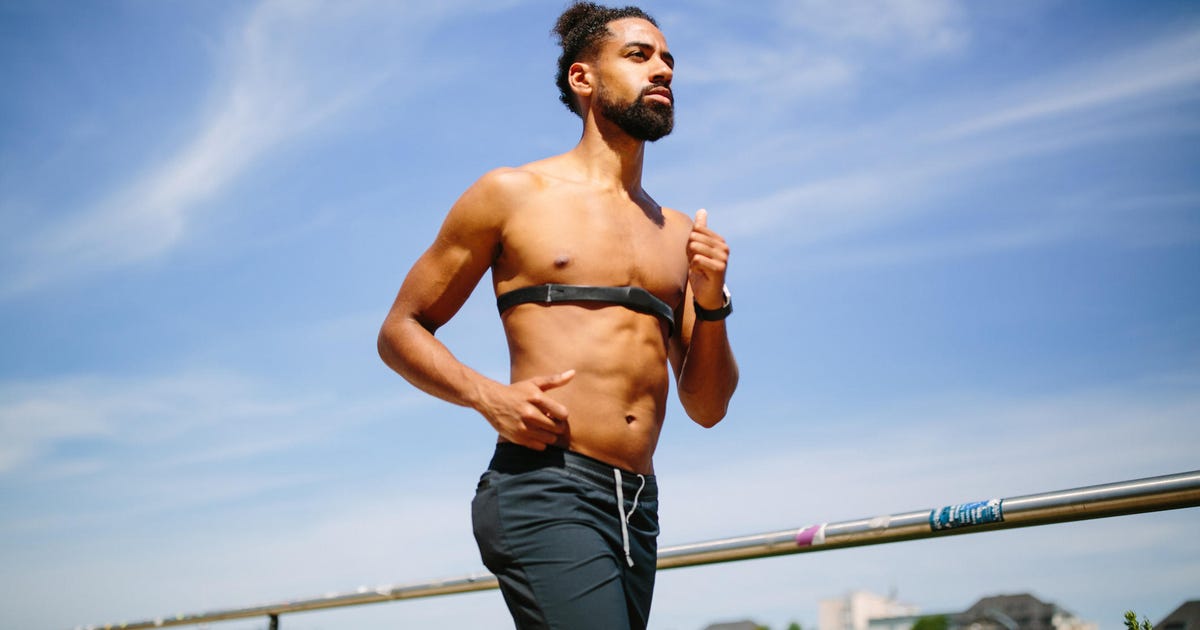The World Health Organization says that all adults should be exercising for at least two and a half hours a week when performing moderate workouts — that number drops to a minimum of 75 minutes per week if the workout is particularly rigorous. No matter how much you’re working out, a good way to track exactly how difficult your workout is can be done by using a heart-rate monitor. A heart monitor with a stress chest strap is the best workout partner.
When it comes to optimizing your workout session — especially when your sport of choice is a distance-based activity, like running or cycling — data can empower you to get so much more out of each workout on a short-term and long-term basis. Heart-rate monitoring can help you track your cardiovascular and overall health.
Gathering metrics like your speed, heart rate, distance, calories burned, stride length, cadence, altitude and elevation can help you fine-tune your training plan to reach a specific fitness goal. That’s why finding the best heart-rate monitor with a chest strap that’s comfortable to wear (and pairing it with a handy fitness app on your smartwatch or a fitness tracker like a Fitbit Versa or Fitbit Charge) is so essential for your fitness goals and health.

Using a chest strap heart-rate monitor can give you accurate, actionable insights to help improve your running.
Getty Images
Of all the different types of heart-rate monitors out there, chest straps are some of the best for distance athletes because they tend to get more accurate heart-rate data readings than an armband, wrist monitor or traditional fitness tracker. Chest straps have a reputation for being uncomfortable and chafing, but with a good heart-rate monitor, you’ll forget it’s even there — until you check your heart monitor reading at the end of your workout session. Below, you’ll find our picks for the best chest strap heart-rate monitors. We update this list periodically as new models become available.
Polar
Polar’s H10 really wowed me, but I have to wonder if it was because I was using a Polar watch as my basis for comparison. The H10 is accurate (as compared to Polar Ignite heart-rate data), reliable, comfortable and compatible. It’s iOS- and Android-friendly, using Bluetooth and ANT Plus connectivity to pair with a variety of devices.
The silicon friction dots along the strap minimize shifting and slipping, and the buckle easily adjusts for a good fit. The H10 supports two simultaneous Bluetooth connections, so if you wear a smartwatch and use fitness hardware such as a stationary bike or rowing erg, you can connect to both. If your gym equipment uses ANT Plus technology, you can potentially enable up to three bluetooth device connections at once.
The only negative that I noticed was that the Polar H10 only has enough onboard memory for one training session. No biggie if you remember to sync to your phone or watch after your run, but that data is lost if you forget and go for a run the next day.
Wahoo
The extra-wide heart-rate chest strap on the Wahoo Tickr X makes this chest strap heart-rate monitor extremely comfortable. The fabric feels soft, and the band is easy to adjust. I was able to get the best, snuggest fit with this strap compared to the others I tested, but it’s unlikely that’ll be the case for everyone. It fits chests from 23 to 48 inches.
In addition to offering extreme comfort, the Wahoo Tickr X also offers comprehensive compatibility. This heart-rate strap connects to just about anything, including iPhone and Android devices, Garmin watches and more than 50 fitness apps.
The updated version of the Wahoo Tickr X supports up to three simultaneous Bluetooth connections, which is convenient if you want to sync your heart-rate monitoring to both a wrist-worn activity tracker and your phone. However, you won’t need to cart along your phone while running with the Wahoo Tickr X, because it has 50 hours of onboard memory that stores heart rate, helping to track heart-rate variability, checking for target heart rate and calories burned data.
Read more: 18 Health and Fitness Devices That Sync With Apple Watch
Garmin
This heart-rate monitor is small, lightweight and captures six cool running metrics: cadence, vertical oscillation (“bounce” in your run), ground contact time, left/right balance, stride length and vertical ratio (oscillation height-to-stride-length). Wearing the HRM-Run made me feel much more like a serious runner than I am — or at least than I have been for the last six or seven months.
The Garmin HRM-Run comes with an impressively long battery life: It lasts for an entire year, assuming you run for an hour per day, once a day. For me (and many other casual runners), this chest strap would last much longer than a year. For serious runners, the long battery life eliminates the need for bothersome weekly charging or, heaven forbid, heading out for a run only to realize your heart-rate monitor is dead.
Garmin knew its target audience with this heart-rate sensor product, as it’s thin, lightweight and comfortable, too. This Garmin device accompanied me on my longest run throughout the testing phase for this project — an eight-miler — and I didn’t chafe or feel uncomfortable at all.
CooSpo
If you’re looking for a heart-rate measurement budget buy to take your workout to the next level, this is it. The CooSpo H6 chest strap uses ANT Plus technology and Bluetooth, which allows it to sync and work wirelessly with the devices you probably already have.
This Bluetooth heart-rate monitor only works if you have a compatible heart-rate tracking app or device that can sync with the CooSpo device. For example, if you use Strava to track your runs, you can sync Strava to the chest strap to get your readings. The CooSpo strap also syncs to Zwift, Peloton hardware, Polar devices, Map My Ride, Wahoo Fitness, Endomondo, UA Run, Garmin devices and more.
This chest strap is soft and comfortable, and the battery life is impressive with 300 hours of use. The strap is also waterproof, and while I didn’t test it in water or rain, I did test it while running in Louisiana, where the humidity makes the air feel like soup — and it held up just fine.
Garmin
If you’re a duathlete or triathlete looking for a chest strap heart-rate monitor, I suggest going with the Garmin HRM-Tri, which is specifically designed to accommodate triathletes. This chest strap captures all the data that triathletes need to track and reports it all back to fitness apps on any compatible devices you sync it to.
Like the HRM-Run (below), the built-in accelerometer on the HRM-Tri measures cadence, vertical oscillation and ground contact time data while running, and when you’re in the water, the strap sensor stores heart-rate data, which it sends to your device later. (The heart-rate tracker can’t actually transmit data while in the water.)
In terms of comfort, the Garmin HRM-Tri is extremely lightweight, so much so that I barely noticed it while running. I didn’t wear it to swim, but I noticed that it seemed to soak up less sweat than the other chest straps I tried, alluding to substantial water resistance.
How to choose a chest strap heart-rate monitor
When it comes to choosing the best heart-rate monitor chest strap for your workout, many of the factors in your buying decision will be based on personal preferences and your workout regimen. Here are a few factors to keep in mind while shopping.
Strap width: This comes down to personal preference, but before you buy, consider whether you’d be more comfortable with a heart-rate tracker that uses a slim strap or a wider one during your workout.
Module size: Some chest straps use tiny modules (the plastic puck-like part) that don’t extend over the edges of the strap. Others, however, use larger monitors to measure your heart rate. Which heart-rate sensor you choose to track your workout also depends largely on personal preference, as well as how tight your running shirts are.
Internal memory: If you don’t like to hold your smartphone during your workout, opt for a heart-rate training monitor that can store your heart-rate data on its own built-in memory to store maximum heart rate, heart-rate variability and target heart rate. You can later transfer your heart-rate reading to your smart phone apps via your HR monitor’s companion app.
Metrics: Consider what you want your monitor to, well, monitor during your workout. Higher-end models capture real-time data covering everything from run cadence to stride length, as well as things like blood pressure, calorie burn and heart-rate variability to help you reach your fitness goal, while more basic models might track only your heart rate.
Battery: A wearable chest strap monitor can have all kinds of power sources. Some have a rechargeable battery. Others may have super-long battery life, but the battery isn’t user replaceable or rechargeable. A longer battery life is always convenient — no one wants a monitor to peter out during a run — but there are lots of options. Make sure to check the description for battery life before purchasing a monitor.
How I chose chest strap heart-rate monitors
I ran with several heart-rate monitors to find the best chest strap monitors for runners. I wore each chest strap on every run for two weeks straight, which came out to six runs per monitor. (Between this project and testing face masks for running, my cardiovascular health must be better than it has been in a while.)
I rated them on comfort, breathability, battery life and accuracy as compared to my Polar Ignite watch, which captures my heart rate throughout runs. While this might not be the best method of testing for accuracy, it’s what I had available to me, and the Polar Ignite is very consistent, so it served as a good comparison.
The information contained in this article is for educational and informational purposes only and is not intended as health or medical advice. Always consult a physician or other qualified health provider regarding any questions you may have about a medical condition or health objectives.






